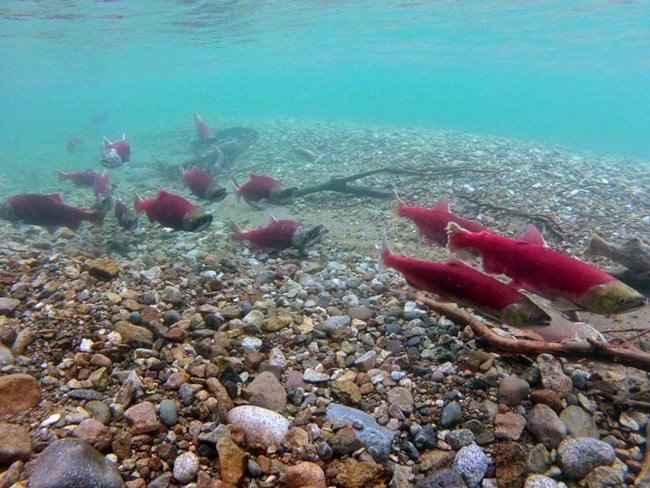Last updated: October 26, 2021
Article
Salmon Spawning and Climate Change
One of the strongest signals of climate change across species is evident in the timing of key life cycle events. For sockeye salmon, the timing of two of these events – hatching from eggs and emergence from gravel – reflects both the timing of reproduction and the temperature under which development occurs. Here, we revised an existing developmental model to predict hatching and emergence timing for 25 sockeye salmon populations in western Alaska, including three populations from Lake Clark National Park and Preserve. Our goal was to explore current patterns in sockeye salmon hatching and emergence timing across habitats, and potential responses to warming water temperatures. According to our model, hatching and emergence currently span broad time periods: specifically, from September of the year of spawning to June of the following year for hatching, and from December of the year of spawning to August of the following year for emergence. These broad time periods indicate that both hatching and emergence timing vary more widely than spawning timing, even for populations entering the same nursery lake. The marked variation in hatching and emergence timing among nearby populations may serve to buffer the Bristol Bay sockeye salmon, as a whole, from climate change.

NPS/Dan Young
Influences of spawning timing, water temperature, and climatic warming on early life history phenology in western Alaska sockeye salmon
Abstract
We applied an empirical model to predict hatching and emergence timing for 25 western Alaska sockeye salmon (Oncorhynchus nerka) populations in four lake-nursery systems to explore current patterns and potential responses of early life history phenology to warming water temperatures. Given the temperature regimes sockeye salmon experienced during development, we predicted hatching to occur in as few as 58 days to as many as 260 days depending on spawning timing and temperature. For a focal lake spawning population, our climate–lake temperature model predicted a water temperature increase of 0.7 to 1.4 °C from 2015 to 2099 during the incubation period, which translated to a hatching timing that was 16 to 30 days earlier. The most extreme warming scenarios shifted development to approximately 1 week earlier than historical minima and thus climatic warming may lead to only modest shifts in phenology during the early life history stage of this population. The marked variation in the predicted timing of hatching and emergence among populations in close proximity on the landscape may serve to buffer this metapopulation from climate change.
Sparks, M. M. , J. A. Falke, T. P. Quinn, M. D. Adkison, D. E. Schindler, K. Bartz, D. Young, and P. A.H. Westley. 2018. Influences of spawning timing, water temperature, and climatic warming on early life history phenology in western Alaska sockeye salmon. Canadian Journal of Fisheries and Aquatic Sciences.
